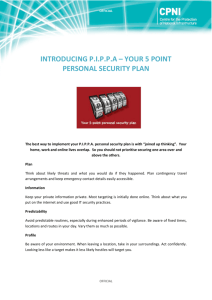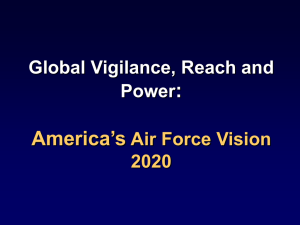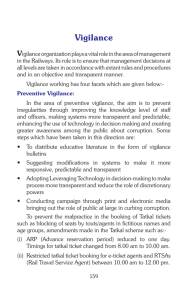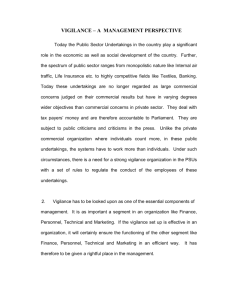Designing for Vigilance during Intermittent Use
advertisement
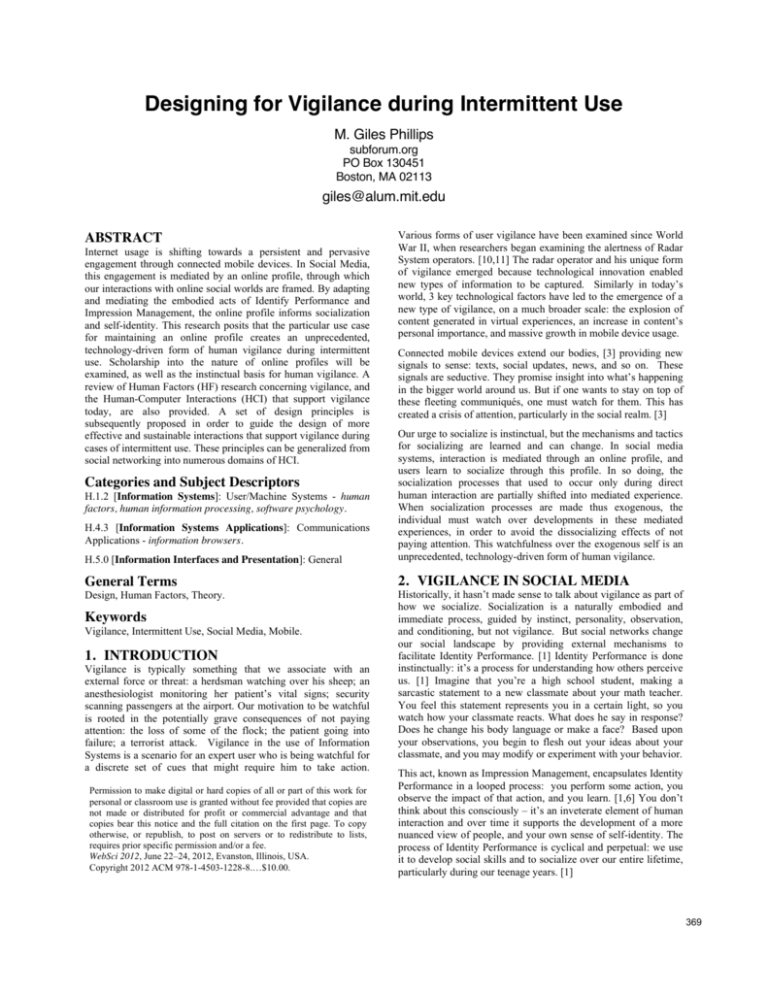
Designing for Vigilance during Intermittent Use M. Giles Phillips subforum.org PO Box 130451 Boston, MA 02113 giles@alum.mit.edu ABSTRACT Internet usage is shifting towards a persistent and pervasive engagement through connected mobile devices. In Social Media, this engagement is mediated by an online profile, through which our interactions with online social worlds are framed. By adapting and mediating the embodied acts of Identify Performance and Impression Management, the online profile informs socialization and self-identity. This research posits that the particular use case for maintaining an online profile creates an unprecedented, technology-driven form of human vigilance during intermittent use. Scholarship into the nature of online profiles will be examined, as well as the instinctual basis for human vigilance. A review of Human Factors (HF) research concerning vigilance, and the Human-Computer Interactions (HCI) that support vigilance today, are also provided. A set of design principles is subsequently proposed in order to guide the design of more effective and sustainable interactions that support vigilance during cases of intermittent use. These principles can be generalized from social networking into numerous domains of HCI. Various forms of user vigilance have been examined since World War II, when researchers began examining the alertness of Radar System operators. [10,11] The radar operator and his unique form of vigilance emerged because technological innovation enabled new types of information to be captureG 6LPLODUO\ LQ WRGD\¶V world, 3 key technological factors have led to the emergence of a new type of vigilance, on a much broader scale: the explosion of FRQWHQW JHQHUDWHG LQ YLUWXDO H[SHULHQFHVDQ LQFUHDVH LQFRQWHQW¶V personal importance, and massive growth in mobile device usage. Connected mobile devices extend our bodies, [3] providing new signals to sense: texts, social updates, news, and so on. These signals are seductive. TKH\SURPLVHLQVLJKWLQWRZKDW¶VKDSSHQLQJ in the bigger world around us. But if one wants to stay on top of these fleeting communiqués, one must watch for them. This has created a crisis of attention, particularly in the social realm. [3] H.5.0 [Information Interfaces and Presentation]: General Our urge to socialize is instinctual, but the mechanisms and tactics for socializing are learned and can change. In social media systems, interaction is mediated through an online profile, and users learn to socialize through this profile. In so doing, the socialization processes that used to occur only during direct human interaction are partially shifted into mediated experience. When socialization processes are made thus exogenous, the individual must watch over developments in these mediated experiences, in order to avoid the dissocializing effects of not paying attention. This watchfulness over the exogenous self is an unprecedented, technology-driven form of human vigilance. General Terms 2. VIGILANCE IN SOCIAL MEDIA Categories and Subject Descriptors H.1.2 [Information Systems]: User/Machine Systems - human factors, human information processing, software psychology. H.4.3 [Information Systems Applications]: Communications Applications - information browsers. Design, Human Factors, Theory. Keywords Vigilance, Intermittent Use, Social Media, Mobile. 1. INTRODUCTION Vigilance is typically something that we associate with an external force or threat: a herdsman watching over his sheep; an DQHVWKHVLRORJLVW PRQLWRULQJ KHU SDWLHQW¶V YLWDO VLJQV VHFXULW\ scanning passengers at the airport. Our motivation to be watchful is rooted in the potentially grave consequences of not paying attention: the loss of some of the flock; the patient going into failure; a terrorist attack. Vigilance in the use of Information Systems is a scenario for an expert user who is being watchful for a discrete set of cues that might require him to take action. Permission to make digital or hard copies of all or part of this work for personal or classroom use is granted without fee provided that copies are not made or distributed for profit or commercial advantage and that copies bear this notice and the full citation on the first page. To copy otherwise, or republish, to post on servers or to redistribute to lists, requires prior specific permission and/or a fee. WebSci 2012, June 22±24, 2012, Evanston, Illinois, USA. Copyright 2012 ACM 978-1-4503-1228-8.« +LVWRULFDOO\LWKDVQ¶WPDGHVHQVHWRWDONDERXWYLJLODQFHDVSDUWRI how we socialize. Socialization is a naturally embodied and immediate process, guided by instinct, personality, observation, and conditioning, but not vigilance. But social networks change our social landscape by providing external mechanisms to facilitate Identity Performance. [1] Identity Performance is done instinctuallyLW¶VDSURFHVVIRUXQGHUVWDQGLQJKRZRWKHUVSHUFHLYH XV >@ ,PDJLQH WKDW \RX¶UH D KLJK VFKRRO VWXGHQW PDNLQJ D sarcastic statement to a new classmate about your math teacher. You feel this statement represents you in a certain light, so you watch how your classmate reacts. What does he say in response? Does he change his body language or make a face? Based upon your observations, you begin to flesh out your ideas about your classmate, and you may modify or experiment with your behavior. This act, known as Impression Management, encapsulates Identity Performance in a looped process: you perform some action, you REVHUYHWKHLPSDFWRIWKDWDFWLRQDQG\RXOHDUQ>@<RXGRQ¶W think about this consciously ± LW¶VDQLQYHWHUDWHHOHPHQWRIKXPDQ interaction and over time it supports the development of a more nuanced view of people, and your own sense of self-identity. The process of Identity Performance is cyclical and perpetual: we use it to develop social skills and to socialize over our entire lifetime, particularly during our teenage years. [1] 369 As a form of public, online networks uniquely impact the acts of Impression Management and Identity Performance. [2] First, our interactions in these networks are generally remembered by the system; they persist. Traces of our interactions can linger on for quite some time, and are discoverable to groups of people at GLIIHUHQW WLPHV 0RUHRYHU ZH GRQ¶W DOZD\V NQRZ VSHFLILFDOO\ who might be online when we communicate, or even comprehend the size of the audience for our communications over time. This is partially due to the persistence of the data in the network, and partially due to the intransigence of the scope of our FRPPXQLFDWLRQVLW¶VKDUGWRJHWDVHQVHRIWKHVL]HDQGUHDFKRI things we say. When we VD\ RU GR VRPHWKLQJ ZH¶UH DFWXDOO\ addressing an imagined audience that may or may not correlate with our true, actual audience. [2] These characteristics of networked publics are designed abstractions of human interaction. Together, they mean that people must develop a new set of skills for Identity Performance. [1] A first-time or novice user of the system must initially become familiar with the rules of the network, and the different ways that she can project her sense of self into the network. Over time, she develops an expert understanding of the facets of her online identity ± how many connections she has, what her profile picture suggests about her, how people react when she does certain things, and so on. She also develops a more solid conceptual model of how all of these facets facilitate Identity Performance. The fact that social media externalizes specific social mechanisms IURP KHU HPERGLHG H[SHULHQFH GRHVQ¶W VWRS KHU IURP GRLQJ Identity Performance; rather, it means that she must watch over her social networks to understand the impacts of her actions. Her vigilance thus emerges: 2.1 The Online Profile Informs Self-Identity An online profile is often thought of as a simple representation of 1 or n dimensions of our physical selves. It is something we control, something we own. Yet for many, and particularly those individuals who discovered social networks in their formative years, the relationship is different. [2,3] Socialization via their online personas is an essential part of their identity; in IDFWLW¶VD fundamental component to how they learned to socialize. Their profile partially defines them. [3] Their network interactions facilitate cyclical acts of Identity Performance exogenously; these DFWVEHFRPHFRUHWRWKHLQGLYLGXDO¶VVHQVHRIVHOI. 2.2 Impression Management Takes Vigilance Because it is exogenous, the social network next needs to be monitored, in order to sustain Impression Management through the online profile. This is the obvious thing about externalized, online Identity Performance LW FDQ EH OHVV LPPHGLDWH ,W¶V GLVHPERGLHG7KHUHLVDV\QFKURQ\:KHQ,FRPPXQLFDWH,FDQ¶W always rely upon any form of immediacy in terms of a response from my audience. They may not be online, or they may not be paying attention at that moment, but my communications persist. So in order to perform Impression Management - to understand the effect of my communications - I have to repeatedly and DFWLYHO\ FKHFN RQ WKH QHWZRUN 7KLV EDVLF ³WDNH DFWLRQ REVHUYH WKH FRQVHTXHQFH´ ORRS LV VWUHWFKHG RYHU DQ indefinite period of time. Fundamentally, once the individual gets his profile set up in the network, he has to watch over it in order to understand how he fits in. This is the basic urge that drives vigilant use. 2.3 Touch Points are Identified Once the user feels the need to be watchful of developments in the network, he begins to recognize all of the touch points in his routine navigation of the physical world that he can create in order to manage the watching. Dad starts logging in on his smart phone during downtime throughout the day. Mom begins logging in while she watches TV. Their son is logging in while he drives. Each is checking for new developments that require action. 3. THE DRIVERS OF VIGILANCE Essentially, vigilance is about an individual preserving her wellbeing, or the well-being of those who are under her care, or those that she cares about. Through the observation of flocking birds DQG KHUGLQJ JURXSV RI PDPPDOV ZH¶YH HVWDEOLVKHG WKDW WKH amount of energy an individual focuses upon vigilance is LQYHUVHO\UHODWHGWRWKHVL]HRIWKDWLQGLYLGXDO¶VJURXS>@7KH larger the size of the community or group of animals, the less vigilant any individual animal will be. Individuals situated along the periphery of the group will tend to be more vigilant than those in the middle of the pack. [9] This suggests that vigilance is LQVWLQFWXDOO\ FRQWH[WXDO DQG LW PDNHV LQWXLWLYH VHQVH LI \RX¶UH DORQJWKHHGJHRIWKHKHUG\RX¶UHPRUHOLNHO\WREHDWDUJHW But interestingly, the most vigilant individuals in the herd must still divide their attention ± the individual along the edge of the herd must sustain vigilance while also trying to eat. This scenario illuminates a few critically important dimensions of vigilance that DUH UHIOHFWHG LQ WRGD\¶V PHGLDWHd worlds. For one, even though the peripheral grazers are eating instead of paying full attention to their watch, they are still able to note and react to the threats. [9] This suggests that some amount of attention is constantly dedicated to vigilance and also that multiple senses are used to be vigilant. Even though the animals are most vigilant while sustaining their watch, they can be sufficiently vigilant while grazing. This also means that vigilance is comprised of bouts of watchfulness; it is not necessarily sustained watchfulness. [9] Vigilant grazers are multitasking: sustaining some amount of attention to vigilance while eating. The social media use case is similar; an active social networker LVQ¶WDOZD\VORRNLQJ+HPD\LQWHUPLWWHQWO\FKHFNRn the network throughout the day, via his smartphone, but for big chunks of his day the smartphone is likely stuffed in his pocket. The signals or cues that prompt a vigilant user to check on the status of the network are one of two things: x x Exogenous cueing: signals in the form of an alert or notification from their device (QGRJHQRXV FXHLQJ WKH XVHU¶V LQWHUQDO LQVWLQFWXDO F\FOH RI Identity Performance; specifically, where the user is engaged in Impression Management Stated another way, an attentive Twitter user will check his phone either when it buzzes at him, or to see if anyone has responded to his tweet. The vigilant user thus sustains some amount of attention to the monitoring of his network for exogenous cues, even during periods of time where he is not actively using the network. Vigilance is not always a case of sustained, focused use of an interface; it can also be a case of sustained awareness and occasional use. 4. VIGILANCE IN HCI As technology has become increasingly sophisticated, we have naturally applied technology to extend our senses and facilitate increased vigilance. Technology provides an extension to our embodied ability to sense: amplifying or translating signals, or providing new signals, so that we can react. As such, vigilance in inIRUPDWLRQ V\VWHPV LV FRQFHUQHG ZLWK D XVHU¶V DWWHQWLRQ IRFXV and ability to detect signals. [11] Vigilance has classically been considered one of three types of attention: [11] x Vigilant (sustained) attention: continuous allocation of processing resources x Divided attention: simultaneously monitoring multiple sensory channels x Selective (focused) attention: monitoring some sensory channels and ignoring others Vigilance is a uniquely taxing state; it consumes time and DWWHQWLRQ DQG LW¶V H[KDXVWLQJ >@ $ NQown phenomenon is the vigilance decrement, which is the tendency of people to overlook or misinterpret signals increasingly over time. [10] The vigilance GHFUHPHQW FRUUHODWHV HLWKHU WR D GHFUHDVH LQ WKH XVHU¶V physiological sensitivity (i.e. through habituation), or to a change LQWKHXVHU¶VGHFLVLRQFULWHULDLHKHUHYROYLQJSHUVSHFWLYHRQKRZ consequential she believes the signal to be.) [11,12] Tactics for reducing the vigilance decrement include increasing the salience of signals, lowering the event rate of signals, and if possible, inserting false signals. [11] Classically, vigilance has been associated with sustained use cases like radar operation, air traffic control, and anesthesiology. [11,12] Prior to the emergence of mobile connectivity, it was safe to assume that vigilant attention would be associated with sustained use, because often as not, usage meant you were glued to a desk. Mobile connectivity has changed that: vigilance is now sustained over bouts of intermittent use in information systems. Thus in order to account for every vigilance scenario in HCI, including the emergent use case in social media, our definition of vigilance must be extended to include intermittent use. 4.1 Baseline Conditioning Vigilance is predicated upon our ability to recognize and evaluate the normalcy of a healthy scenario: a baseline condition. Information systems enable vigilance first by giving the user a sense of what normal looks, feels, or sounds like. In visual displays of information like a graphical user interface, this is DFFRPSOLVKHG E\ D XVHU¶V YLVXDO VHDUFK1 Visual search is a perceptual task in which the user actively scans his visual field in search of target objects or features, among a field of other objects or features, known as distractors. [19,18] As users develop expertise within a particular environment or interface, they will begin to operate with a set of preconceptions that help simplify visual search by constraining the visual field or cueing to particular features in the visual field; these preconceptions may create biases when interacting with new environments. [18,7,14] ,Q WRGD\¶V ZRUOG RI VRFLDO PHGLD DQG VRFLDO FRPSXWLQJ WKH baseline condition is established through use, developing a sense RIZKDW¶VQRUPDOZLWKLQWKH,QIRUPDWLRQ$UFKitecture (IA) of the SURGXFW$VRFLDOQHWZRUN¶V,$RIWHQLQFOXGHV>@ x An online profile which represents the user. x Collections of relations, like your list of friends on a social network, or the list of editors of a wiki document. x Tools for public communication. Messaging, sharing, and activity feed: nuggets of personalized communication. 7KHVH IHDWXUHV EHFRPH WKH O\QFKSLQ RI WKH XVHU¶V FRQFHSWXDO model for interacting within a social networking site. The foundation of vigilance for the social networker is the scanning of these features in order to verify that the baseline condition is met: does she have any new followers? Did she lose followers after her last tweet? Did her friend reply to her message? 1 For a deeper inquiry into visual search, refer to [5,8,13,16,19]. 4.2 Alert Flaring With the baseline condition established, alerts can usually help a vigilant user recognize events that may require her to take action. $Q DOHUW LV DQ\ PHFKDQLVP GHVLJQHG WR FDSWXUH WKH XVHU¶V attention.2 Effective vigilance requires the ability to quickly differentiate real alarms from false alarms and non-threatening occurrences. A major design consideration is the relative salience of the alert signal in all usage contexts. [18,7,8] Because loud or persistent alarms can annoy users, the design of alerts must strike the right balance between false alarms and missed events. [18] 9LVXDODOHUWVDUHUHVWULFWHGWRWKHXVHU¶VYLVXDOILHOGZKLFKFDQEH difficult to predict. [18,19] A salient color can be used - as well as flashing and blinking - LQ RUGHU WR GUDZ D XVHU¶V DWWHQWLRQ WR D particular area in her visual field. [7,18] Other transformations, such as changes in shape or positioning can also be used to signal alerts to the user. [14] Both sound and ergonomic alerts (like tactile vibrations from a mobile phone) can be effective because they are omnidirectional.3 In some scenarios, visual, audio, and/or ergonomic alerts can be combined to increase salience. [18] ,QWRGD\¶VZRUOGRI:HEDQGFRQQHFWHGGHYLFHVYLVXDODOHUWVDUH commonly invoked through salient visual overlays on top of the User Interface (UI), like a badge over an email icon indicating the number of unread messages. These mechanisms can be effective during sustained use, but also when the user is multitasking and her attention is divided. [20,18] In both cases, the user conducts a visual search of the UI in order to establish the baseline condition, and if alert overlays are present or emerge near particular features, they can help the user to identify exceptions. In situations where sustained use cannot be assumed, email is a long-standing and popular alerting mechanism; it is used by most social systems. Email has a number of well-known issues: loss of salience or user desensitization due to the amount of junk and spam that exists in their inbox, messages being caught by spam filters, and no mechanisms for verifying that the email was read. In mobile operation systems, a notification system is typically included. Such systems are often mixed-mode: visual information is displayed, and the device will correspondingly issue an audio chime and/or an ergonomic vibration. An on-screen dialog is generally provided, which enables the user to ignore the alert or to view/take action. These systems are user-configurable, enabling one to tune the salience and differentiation of signal types, often on the fly. Mobile notifications have helped users divorce some of their attention from their online personas while continuing to be watchful over them. But mobility opens the door to myriad contexts of use: it is impossible to know what else the user might be doing while being vigilant. As more services leverage mobile notifications, the relative salience of any single notification may decrease. Increased adoption introduces the risk of over-saturating users, flooding them with alerts that areQ¶WLPSRUWDQW 5. DESIGNING FOR VIGILANCE A user sustaining vigilant attention over intermittent use is uniquely impacted. His attention is divided between mediated and physical experiences. Users may be distracted from, or by, their vigilant state. Building upon the established tactics and shifting 2 [20, 18] do an excellent job of summarizing the rich body of research into user attention and its application. 3 Ergonomic alerts are quite HIIHFWLYH DW JHWWLQJ WKH XVHU¶V attention and can be less annoying than audio. [18] our focus to the design of support for vigilance during intermittent use, the following principles are proposed: 1. Provide a Vigilance Lens. The vigilance lens should be an expert view that users can naturally flow into when they feel WKH QHHG WR EH YLJLODQW DQG RXW RI ZKHQ WKH\¶UH ERUHG RU curious. The vigilance lens must also provide short paths to react: most use cases will conclude with the performance of some action, and this should be made as frictionless as possible. Many social systems today are designed with the opposite goal of keeping users engaged as long as possible, and risk turning vigilance into the gateway for more casual immersion into mediated experiences. 2. Simplify for Visual Search. Remembering that the vigilant user will be an expert user who is familiar with your system, ensure that users can easily establish their baseline condition. The baseline condition should provide a clear framework within which to flare alerts. For users entering your system via an alert, you must provide them with sufficient context to act. 3. Use Intelligent Signal Flaring. Prioritization and batching can be employed to minimize false positives or the alert of non-meaningful activity. Less important signals can be batched together and cued at once, allowing the user to engage less frequently. Alerts may be overloaded to help users quickly establish context; for example, compressing a sequence of events into a timeline the user can quickly step through without entering your system. 4. Introduce variance in Signals. Variance shakes things up and makes the user less likely to dismiss alerts over time, combatting the vigilance decrement. [10,11] For example, consider the tuning of signal salience or timing to correlate with the priority of the alert. 6. NEXT STEPS Future work to further develop this exploration must include research into the applicability of the existing body of HF research of vigilance to this new form of vigilance during intermittent use, including the vigilance decrement and the specific factors that impact it in these systems. Further empirical investigation into XVHU¶V VSHFLILF GHFLVLRQ FULWHULD ZKHQ PRQLWRULQJ DOHUWV LV DOVR needed. Finally, the proposed design principles require further development: while they help to frame the problem of designing for vigilance, they are only the beginning of what should be a much deeper inquiry. 7. CONCLUSION We must reconsider the classical notion of vigilance in HCI: technological innovation has introduced a new form of vigilance that extends over periods of intermittent use. While this article explored the particular phenomenon of vigilance among social networkers, it is a much more broad and growing concern, potentially relevant to any real-time analytics or reporting system, publishing system, or home and health monitoring systems. On one hand, this is an opportunity: businesses might relish in the opportunity to have a more broadly engaged audience %XW LW¶V also our responsibility to design products that users can engage wiWKHDVLO\TXLFNO\DQGLQDZD\WKDWGRHVQ¶WGLVUXSWQDYLJDWLRQ and socialization in the physical world. To support vigilance during intermittent use, we must enable users to be watchful over the developments in our systems with short, efficient workflows. We must also change the way we think about people, how they interact, and how they navigate and occupy physical space. 8. REFERENCES [1] boyd, d. 2007. Why Youth (Heart) Social Network Sites: The Role of Networked Publics in Teenage Social Life. In MacArthur Foundation Series on Digital Learning - Youth, Identity, and Digital Media Volume (ed. Buckingham D.). Cambridge, MA: MIT Press, pp. 119-142. [2] boyd, d. (2010). Social Network Sites as Networked Publics: Affordances, Dynamics, and Implications. In Networked Self: Identity, Community, and Culture on Social Network Sites (ed. Papacharissi Z.), pp. 39-58. [3] Turkle, S. 2011. Alone Together. New York: Basic Books. [4] Dunbar, R.I.M., Cornah, L., Daly, F. J. and Bowyer, K. M. 2002. Vigilance in Human Groups: A Test of Alternative Hypotheses. Behaviour 139 (5): 695-711 [5] Duncan, J. and Humphreys, G. W. 1989. Visual search and stimulus similarity. Psychological Review 96, 433±458. [6] Goffman, E. 1956. The Presentation of Self in Everyday Life. Edinburgh: University of Edinburgh. [7] Knudsen, E. I. 2007. Fundamental Components of Attention. Annual Review of Neuroscience 30(1): 57-78. [8] Leonards, U., Suneart, S., Van Hecke, P., and Orban, G. 2000. Attention mechanisms in visual search - An fMRI study. J. Cogn. Neurosci. 12: 61±75. [9] Lima, S. L. and Bednekoff, P. A. 1999. Back to the basics of antipredatory vigilance: can nonvigilant animals detect attack? Animal Behaviour 58 (3): 537-543. [10] Mackworth, N.H. 1948. The breakdown of vigilance during prolonged visual search. Q. J. Exp. Psychol. 1, 6-21. [11] Parasuraman, R. (ed.). 1998. The Attentive Brain. Cambridge, MA: The MIT Press. [12] Pattyn, N., Neyt, X., Henderickx, D., Soetens, E. (2008). Psychophysiological Investigation of Vigilance Decrement: Boredom or Cognitive Fatigue? Physiol. Behav. 93:369-378. [13] Phillips, M. G. 2007. Design by Searching. (SMarchS Thesis, Dept of Architecture, Massachusetts Institute of Technology, Cambridge, MA) [14] Pratto, F. and John, O. P. 1991. Automatic vigilance: The attention-grabbing power of negative social information. Journal of Personality and Social Psychology 61(3):380-391. [15] Quenette, P-Y. 1990. Functions of vigilance behaviour in mammals: A review. Acta Oecologica 11(6):801-818. [16] Quinlan, P. X. and Humphreys, G. W. 1987. Visual search for targets defined by combinations of color, shape, and size: An examination of the task constraints on feature and conjunction searches. Percept. Psychophys. 41, 455-472. [17] Warm, J. S., Parasuraman, R., and Matthews, G. 2008. Vigilance Requires Hard Mental Work and Is Stressful. Human Factors 50, 433-441 [18] Wickens, C. D. and McCarley, J. S. 2008. Applied Attention Theory. Boca Raton, FL: CRC Press. [19] Wolfe, J. 1998. Visual search. In Attention (ed. Pashler H.). Hove, England: Psychology Press, pp. 13-73. [20] Wright, R.D. and Ward, L.M. 2008. Orienting of Attention. Oxford University Press
